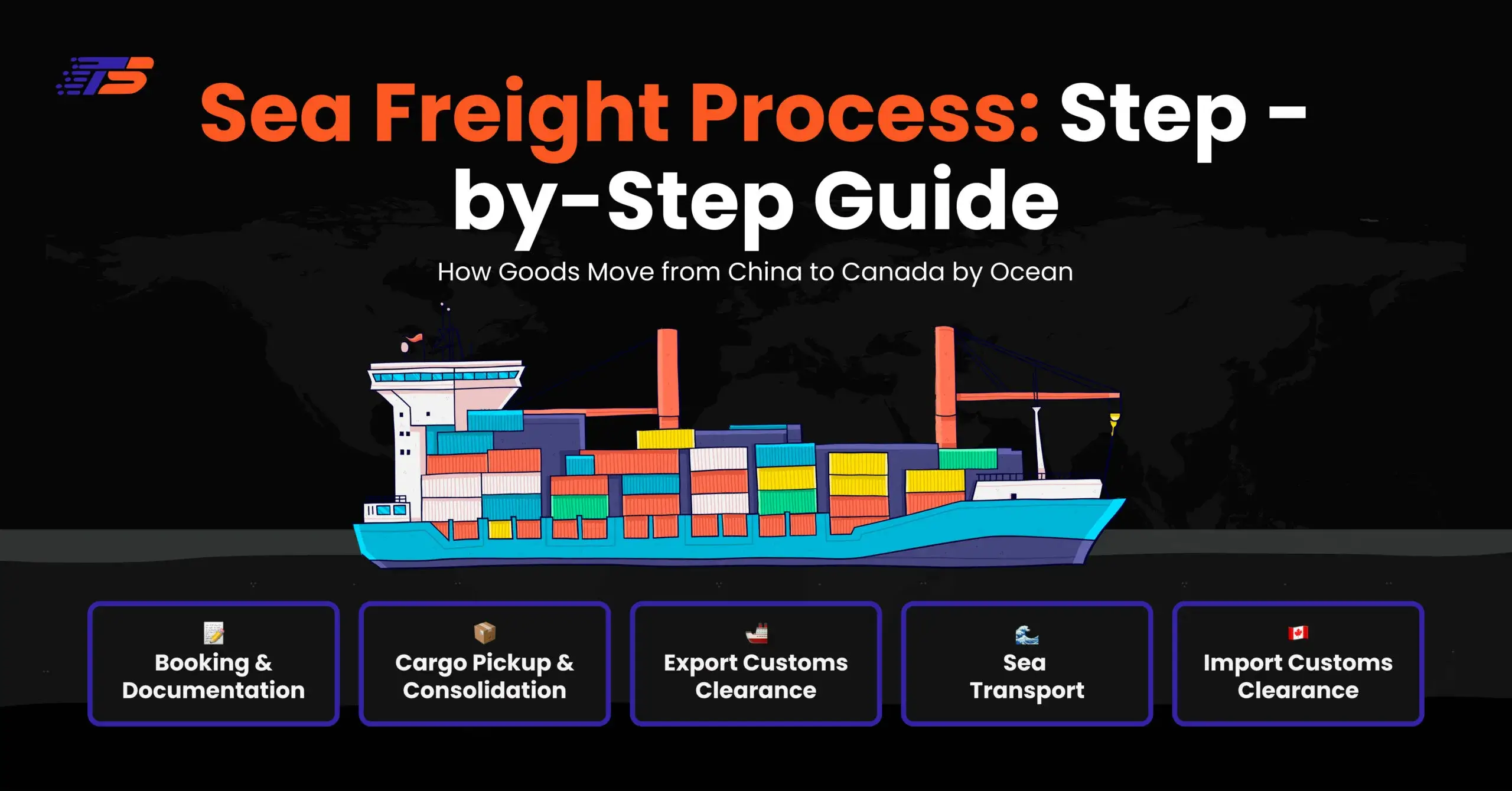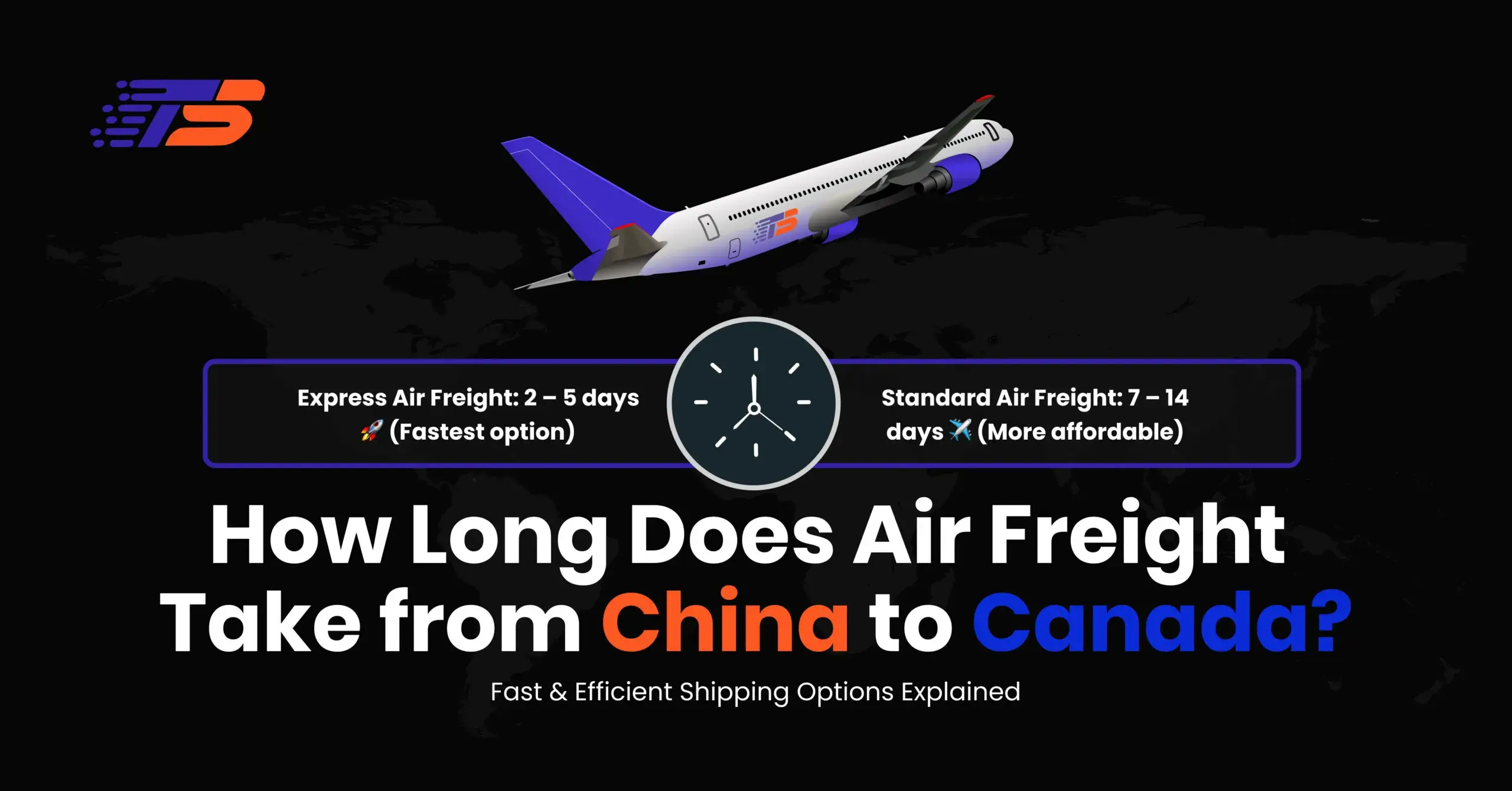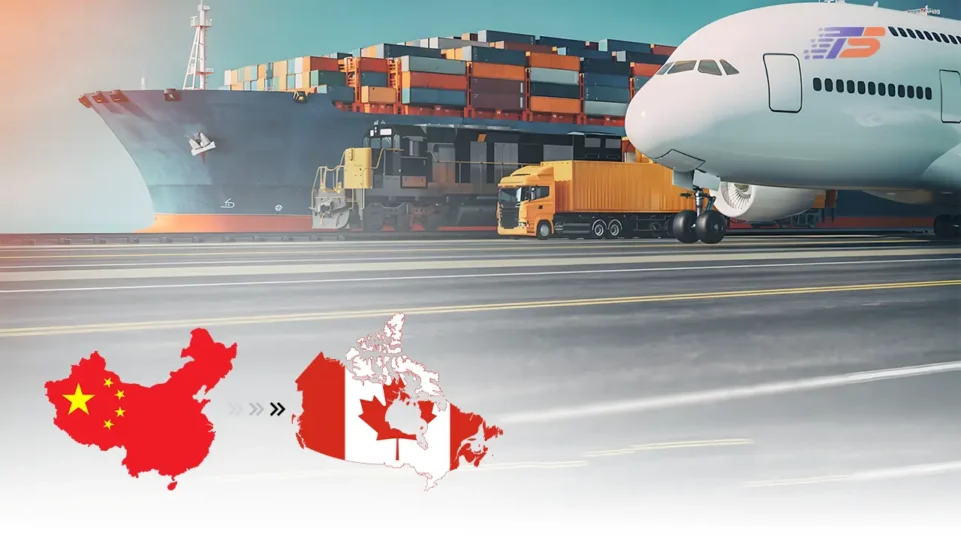Canada’s imports from China reached $64.69 billion in 2024, reflecting the strength of a trade relationship that demands reliable and cost-effective shipping solutions. Ontario alone recorded $23.10 billion in imports during Q2, highlighting the importance of optimized strategies across every province. This growth aligns with broader trends in global commerce, where shipping routes from China play a central role in connecting suppliers to major markets.
Shipping from China to Canada: 2025 Market Update & Trends
For Canadian importers, success depends on choosing the right balance of speed, cost, and reliability. With clear understanding of these options, businesses can protect margins and keep supply chains resilient.
Costs
- Express (up to 45kg): ~$142 total
- Air freight (100-300kg): ~$26/kg
- Air freight (300-500kg): ~$17/kg
- Sea freight (20′ container): $3,050-5,550
- Sea freight (40′ container): $3,050-5,550
Delivery Times
| Mode | Route | Cost Range | Transit Time |
| Express | China → Canada | $13.13-18.09 (under 10kg) | 1-5 days |
| Air Freight | China → Canada | $17-26/kg | 3-10 days |
| Sea Freight (FCL) | China → Canada | $3,050-5,550 | 25-45 days |
| Regular Post | China → Canada | Varies | 1-2 weeks |
Comparing Shipping Methods from China to Canada
Choosing your shipping method depends on balancing cost, time, and cargo requirements. Sea freight is the most economical option for bulk shipments and heavy cargo, but transit times are longer. If your priority is cost management, sea freight may be a more suitable option, while many businesses are now choosing express for time-sensitive shipments . Consider your product category, seasonal demands, and inventory turnover when evaluating options.
| Method | Transit Time | Best For |
| Express Courier | 1-3 days | Urgent samples, high-value lightweight goods, time-critical shipments |
| Air Freight | 3-5 days | Medium-volume shipments, seasonal inventory, perishable goods |
| Sea Freight LCL | 20-40 days | Small to medium volumes, non-urgent inventory replenishment |
| Sea Freight FCL | 30-40 days door-to-door | Large volume shipments, seasonal stock builds, cost-sensitive cargo |

Efficient Door-to-Door Canada Delivery
Door-to-door shipping from China to Canada eliminates the complexity of managing multiple logistics providers by offering complete end-to-end service from supplier pickup to final delivery at your Canadian business location. Professional freight forwarders handle every step including export documentation, international transit, customs clearance, and domestic delivery across major Canadian cities like Vancouver, Toronto, Montreal, and Calgary.
This comprehensive approach reduces administrative burden while ensuring smooth customs processing through experienced clearance teams who understand Canadian import requirements and documentation standards.
Amazon FBA Shipping: China-Canada
Specialized Amazon FBA prep services for China-Canada shipments provide a fully integrated solution that includes product inspection, compliant packaging, labeling, and direct delivery to Amazon fulfillment centers across Canada. In addition to ensuring full compliance with Amazon’s preparation standards, experienced forwarders also handle customs clearance, duty payments, and all required documentation under DDP terms, often starting with pickup directly from major Chinese manufacturing hubs. This streamlined approach not only minimizes operational risks and delays but also offers sellers transparent, all-in costs while optimizing packaging to reduce storage fees and maintain compliance.
Types of Shipping Containers for Ocean Freight
Ocean freight relies on a variety of container types, each designed to handle specific cargo needs. While standard containers remain the most common choice, there are also specialized options for oversized, fragile, or temperature-sensitive goods. The table below outlines the main types of shipping containers and how they support different logistics requirements.
| Container Type | Internal Dimensions (L × W × H) | Max Volume (CBM) | Best Use Case |
| 20ft Standard (GP) | 5.90m × 2.35m × 2.39m | 33.1 CBM | Medium-sized shipments, 2-bedroom apartment contents |
| 40ft Standard (GP) | 12.03m × 2.35m × 2.39m | 67.3 CBM | Large volume shipments, mixed cargo |
| 40ft High Cube (HC) | 12.03m × 2.35m × 2.69m | 60-68 CBM stackable goods | Light, bulky goods, maximum volume needs |
| 20ft Open Top | 5.90m × 2.35m × 2.35m | 32.5 CBM | Oversized cargo, machinery, construction materials |
| 40ft Open Top | 12.03m × 2.35m × 2.35m | 66.7 CBM | Large machinery, industrial equipment |

Transit Times for China to Canada Shipments
Understanding transit times is crucial for planning shipments from China to Canada. The following table provides a clear comparison of average transit times for various shipping methods, helping you make informed decisions to optimize your supply chain efficiency and meet delivery expectations with confidence.
| Shipping Method | Transit Time (Port/Airport to Port/Airport) | Customs Clearance & Handling | Total Estimated Delivery Time (Door-to-Door) | Best Suited For |
| Express Courier | 1-3 days | Same day processing | 1-5 days total | Samples, urgent documents, high-value small items |
| Air Freight | 8-10 days | 2-4 days | 8-10 days | Medium volume, time-sensitive cargo |
| Sea Freight (FCL) | 25-45 days | 3-7 days | 29-33 days | Large volume, cost-sensitive shipments |
| Sea Freight (LCL) | 25-45 days | 5-10 days | 35-50 days | Small to medium cargo volumes |
| Regular Post | 1-2 weeks | 1-3 days | 1-2 weeks | Low-value, non-urgent items |

Factors Affecting China-Canada Shipping Time
- Seasonal demand: Chinese New Year, Golden Week, and peak retail seasons push export volumes higher, leading to longer loading times in ports like Shanghai or Shenzhen and slower customs clearance once goods arrive in Vancouver or Toronto.
- Weather disruptions: North Pacific storms, fog, or typhoons often delay vessels route to Canada’s West Coast, while heavy snow in Vancouver, Calgary, or Toronto can affect air freight schedules.
- Port congestion: During peak trade cycles, Canadian gateways such as Vancouver and Prince Rupert face significant backlogs, with vessels sometimes anchored offshore for days before unloading.
- Customs inspections: Import checks at Canadian ports can add several days. Electronics, chemicals, and food shipments are especially prone to delays under Canadian Border Services Agency (CBSA) review.
- Route complexity: Direct sailings (e.g., Shanghai → Vancouver) are quicker, but transshipments through hubs like Busan, Hong Kong, or Singapore may extend total transit time considerably.
- Documentation issues: Errors in invoices, HS codes, or missing permits can delay clearance at Canadian customs, adding 2-7 days for corrections.
- Cargo type (LCL vs. FCL): LCL shipments take longer due to consolidation in China and deconsolidation in Canada, while FCL containers move more efficiently through Canadian ports.
China to Canada Pricing Guide: Optimize Your Shipping Budget
Shipping costs from China to Canada fluctuate based on multiple factors including shipment size, mode of transport, and current market conditions. The following pricing guide and cost factors overview will help you navigate varying freight rates, seasonal surcharges, and additional fees to optimize your shipping expenses with confidence.
| Service Type | Cost Range | Minimum Charge | Best For | Estimated Transit Time (Door-to-Door) |
| Express Courier | $5.00/kg | $13.13-18.09 (under 10kg) | Samples, urgent documents, high-value items | 1-3 days |
| Air Freight | $5.50-6.00/kg | $100 handling fee | Medium volume, time-sensitive cargo | 3-5 days |
| Sea Freight (20ft) | $2,327-4,700 | Port charges apply | Large volume, cost-sensitive shipments | 30-40 days |
| Sea Freight (40ft) | $3,395-7,000 | Port charges apply | Maximum volume efficiency | 30-40 days |
| Regular Post | Varies by weight | $10-15 | Low-value, non-urgent items | 1-2 weeks |
Shipping Cost Example: Small e-commerce shipment of 150 kg electronics from Shanghai to Toronto via air freight
- Total cost: $825 (including customs clearance)
- Transit time: 5 days
Factors Affecting China-Canada Shipping Costs
- Shipment Weight & Volume: Higher weights reduce per-kg rates, but dimensional weight pricing applies for bulky items
- Seasonal Demand: Peak seasons like Chinese New Year and pre-holiday periods increase rates by 15-30%
- Fuel Surcharges: Fluctuating oil prices directly impact air and sea freight costs through fuel adjustment factors
- Port Selection: Major ports like Vancouver offer better rates than secondary ports due to higher cargo volumes
- Service Speed: Express services command premium pricing compared to standard transit options
- Cargo Type: Hazardous materials, fragile items, or temperature-controlled goods incur additional handling fees
- Exchange Rate Fluctuations: USD/CAD/CNY currency movements affect final pricing for importers
- Insurance Coverage: Optional cargo insurance typically costs 0.1-0.3% of shipment value
Alternative Cost-Saving Route
Is Canada Your Best Choice? Some businesses actually save 15-25% by importing through major US ports like Los Angeles or Long Beach, then trucking goods across the border. This happens because higher shipping volumes to the US often mean lower container rates, more frequent sailings, and better infrastructure options.
If you’re considering this strategy or simply want to compare your options, understanding the complete landscape of shipping from China to US is essential, as US ports handle significantly more Chinese cargo than Canadian ports, which often translates to better pricing and flexibility for high-volume importers.
Main Shipping Routes from China to Major Canadian Ports
Efficient trade between China and Canada relies on key shipping routes connecting major Chinese ports—Shanghai, Shenzhen, Ningbo to Canadian gateways like Vancouver, Montreal, and Toronto.
Major Departure Ports in China
- Shanghai Port: China’s busiest container port, offering multiple weekly services to Canadian destinations
- Shenzhen Port: Major gateway for South China exports, particularly electronics and manufactured goods
- Ningbo-Zhoushan Port: Strategic location near Shanghai with competitive rates for bulk shipments
- Guangzhou Port: Key port for Pearl River Delta manufacturers shipping to North America
- Qingdao Port: Northern China’s primary port offering direct services to Canadian west coast
- Tianjin Port: Serves Beijing region and northern manufacturing centers
- Xiamen Port: Growing hub for Southeast China exports with regular Canada connections
Primary Arrival Ports in the Canada
- Port Metro Vancouver: Canada’s largest port handling 60% of China-Canada trade volume
- Port of Prince Rupert: Western gateway with shorter transit times from Asia
- Port of Montreal: Eastern Canada’s primary container terminal serving Quebec and Ontario markets
- Port of Halifax: Atlantic gateway offering competitive rates for eastern Canadian destinations
- Port of Toronto: Great Lakes access point for central Canada distribution
Efficient Route Combinations
- Shanghai to Vancouver: Most popular route with daily departures, 14-18 day transit
- Shenzhen to Montreal: Trans-Pacific + rail combination serving eastern Canada markets
- Ningbo to Prince Rupert: Fast 12-15 day service with efficient rail connections
- Guangzhou to Vancouver: Direct service favored by electronics and consumer goods importers
- Qingdao to Halifax: Cost-effective option for eastern Canadian distribution
Air Freight Hubs
- Toronto Pearson International (YYZ): Canada’s busiest cargo airport handling 40% of air freight
- Vancouver International (YVR): Primary Pacific gateway for China-Canada air cargo
- Montreal-Pierre Elliott Trudeau (YUL): Eastern Canada’s main air freight hub
- Calgary International (YYC): Regional hub serving western Canadian markets
- Hamilton International (YHM): Canada’s largest overnight express cargo airport for e-commerce
Customs, Duties, & Insurance in China-Canada Shipping
Moving goods across borders involves more than just transportation. Customs clearance, import duties, and insurance all play a crucial role in successful China-Canada shipping. These factors not only affect overall costs but also determine how smoothly cargo moves through the supply chain. The following section highlights the key elements to consider when managing compliance and protecting your shipments.
Canada Customs & Import Duties
- GST/HST: 5-15% GST applies to most imported goods depending on province
- Customs Duties: Range from 0-20% based on product classification and country of origin
- Processing Fees: $9.95 for courier shipments under $100, higher for commercial imports
- Documentation Required: Commercial invoice, packing list, bill of lading, import permits if applicable
- Clearance Timeline: 1-3 days for standard shipments, longer for inspections or missing documents
Cargo Insurance Protection
- Coverage Options: Typically 110% of invoice value plus freight costs
- Premium Rates: 0.1-0.3% of shipment value for standard coverage
- Protected Risks: Loss, damage, theft during transit including loading/unloading
- Claim Process: Report within 30 days, requires survey reports and supporting documentation
- Recommended For: High-value shipments, fragile goods, or first-time suppliers
HS Codes for China-Canada Shipping
When importing goods from China to Canada, correctly identifying the HS code for each product is essential, as tariff classification is necessary to import goods into Canada.
- Standardized Classification System: HS codes are an internationally recognized 6-digit system used to classify traded products worldwide.
- Structured Format: Codes are organized hierarchically, 2 digits for chapter, 4 digits for heading, and 6 digits for subheading.
- Mandatory Requirement: Tariff classification using HS codes is legally required for all goods imported into Canada from China.
- Multiple Functions: Used to calculate customs duties, import taxes, and help authorities identify, track, and control shipments.
- Trade Compliance: Proper classification ensures smooth customs clearance and prevents potential penalties or shipment holds
Incoterms and Delivery options for China-Canada Shipping
- FOB (Free on Board): Buyer controls shipping, pays all costs after goods leave Chinese port
- CIF (Cost, Insurance, Freight): Seller pays shipping to Canadian port, buyer handles customs
- DDP (Delivered Duty Paid): Seller handles everything including Canadian customs and duties
- DDU (Delivered Duty Unpaid): Seller delivers to Canada, buyer pays customs duties and taxes
- EXW (Ex Works): Buyer responsible for all shipping from supplier’s premises
DDP vs DDU: Best Shipping Terms for China to Canada
DDP Benefits:
- Supplier handles all Canadian customs clearance and duty payments
- Predictable landed costs with no surprises at delivery
- Faster clearance as supplier often has established customs broker relationships
DDU Benefits:
- Lower upfront costs as duties paid separately at destination
- Buyer maintains control over customs process and broker selection
- Better for large importers with established customs relationships
Recommendation: New importers prefer DDP for simplicity, while experienced buyers often choose DDU for cost control and flexibility.
Freight Forwarder Support: China to Canada
Shipping from China to Canada becomes seamless with the right freight forwarding partner. We manage every step from factory pickup in major Chinese manufacturing hubs to delivery at your warehouse or distribution center in Toronto, Vancouver, Montreal, Calgary, and cities across Canada.
Our experienced team ensures fast, cost-efficient transit via sea freight, air cargo, or express courier services, with secure handling, transparent pricing, and smooth Canadian customs clearance. Navigate complex cross-border regulations confidently while maintaining control over your supply chain costs and delivery schedules through our comprehensive China-Canada freight forwarding solutions.
How To Choose The Right Freight Forwarder?
A forwarder is more than a booking agent; they provide strategic insight and operational certainty. From navigating Canadian customs requirements to recommending the most efficient ports and airports, the right partner ensures cargo moves with minimal disruption.
Consolidation options reduce costs, accurate documentation prevents delays, and tailored solutions protect fragile or temperature-sensitive goods. By combining flexibility with end-to-end support, importers secure on-time delivery, stronger cost control, and a reliable connection between Chinese suppliers and Canadian distribution hubs.
Real-Time Cargo Tracking from China to Canada
Uncertainty turns into control when every shipment is traceable with China’s freight tracking solutions from factory floor to final delivery in Canada. Modern tracking tools GPS, RFID, and customs-linked platforms deliver live updates on cargo location, clearance progress, and transit timelines. Importers gain a single dashboard to monitor multiple shipments at once, avoiding constant back-and-forth communication.
For businesses managing inventory cycles, production schedules, or seasonal launches, real-time visibility is more than convenience it’s a safeguard against costly disruptions. With accurate delivery windows and clear status updates, supply chains remain predictable and customers stay informed.
Service-Based Tracking
| Tracking Type | Monitoring |
| Express Courier Tracking | Door-to-door visibility with GPS updates every few hours, pickup confirmation, customs clearance status, and proof of delivery |
| Air Freight Tracking | Flight departure/arrival times, customs processing updates, and ground transport coordination from airport to final destination |
| Sea Freight Container Tracking | Vessel departure from Chinese ports, real-time position updates during ocean transit, arrival at Canadian ports, and inland transportation status |
| LCL Cargo Tracking | Consolidation warehouse updates, container loading confirmation, deconsolidation tracking, and final mile delivery coordination |
| Customs Clearance Tracking | Documentation submission status, inspection schedules, duty payment confirmation, and release authorization updates |
| Multi-Modal Tracking | Integrated visibility across transportation modes with seamless handoff notifications between carriers |
Additional Considerations for China to Canada Shipping
Specialized cargo requirements and regulatory compliance significantly impact China-Canada shipping success, requiring careful planning beyond standard freight considerations.
Sensitive & Special Cargo Handling
- Temperature-Controlled Shipments: Electronics from Guangdong factories and food products require reefer containers with continuous monitoring during 25-35 day Pacific crossings
- Lithium Battery Shipments: Chinese electronics manufacturers must comply with IATA DGR regulations for air freight and IMDG codes for sea transport to Canadian destinations
- High-Value Technology: Smartphones, laptops, and semiconductors from Shenzhen need enhanced security protocols and comprehensive insurance during Vancouver or Toronto port clearance
- Fragile Consumer Goods: Glassware, ceramics, and delicate items from Chinese suppliers require specialized cushioning and “fragile” handling throughout Canadian distribution networks
- Oversized Machinery: Heavy equipment from Chinese manufacturers needs break-bulk vessels and specialized crane handling at Prince Rupert or Montreal ports
Prohibited and Restricted Items
- Completely Prohibited: Counterfeit branded goods, wildlife products, and certain Chinese-made electronics on security restriction lists cannot enter Canada
- Health Canada Approval Required: Traditional Chinese medicines, dietary supplements, and cosmetics need pre-market authorization before importation
- CFIA Restrictions: Food products, wooden packaging materials, and plant-based items from China face strict Canadian Food Inspection Agency requirements
- Anti-Dumping Measures: Certain Chinese steel products, textiles, and solar panels may face additional duties or import restrictions under Canadian trade remedies
- Documentation Requirements: Electronics and machinery must include English/French labeling, safety certifications, and compliance with Canadian electrical standards
Final Overview: Navigating China-Canada Shipping
Efficient shipping from China to Canada hinges on choosing the right transportation method for your cargo. Express courier services are ideal for urgent small shipments, delivering in 1–5 days, while air freight balances speed and cost for medium-sized shipments within 8–10 days. Sea freight remains the most cost-effective solution for bulk cargo, with transit times of 30–40 days.
To optimize total landed costs—including freight, duties (0–20%), and GST/HST (5–15%)—importers should plan around seasonal surcharges and port congestion. Partnering with experienced freight forwarders ensures seamless customs clearance, accurate documentation, and optimized logistics tailored to your shipment type.
Leveraging real-time tracking tools provides full visibility from factory to door, allowing businesses to maintain predictable supply chains, minimize delays, and meet delivery expectations across Canadian markets. By combining strategic planning, reliable partners, and operational transparency, importers can confidently navigate China-Canada shipping and secure efficient, cost-effective delivery.
FAQ: Shipping From China to Canada
What is the best way to ship from China to Canada?
The best shipping method depends on your cargo type, budget, and urgency. For bulk goods, sea freight is the most economical. For smaller, urgent shipments, air freight or express couriers like DHL, UPS, or FedEx are faster and more reliable.
What is the cheapest way to ship from China to Canada?
The cheapest option is usually sea freight (LCL or FCL). If you ship small parcels under 2 kg, China Post or ePacket can also be cost-effective, though delivery is slower.
What is standard shipping from China to Canada?
Standard shipping typically refers to postal services like China Post Registered Airmail or ePacket. These services are affordable but take longer than air or express freight usually 2-6 weeks.
Do I have to pay duty on items shipped from China to Canada?
Yes. Most items are subject to duty and GST/HST upon arrival in Canada. The exact amount depends on the product type, value, and Canada Border Services Agency (CBSA) regulations.
How to import things from China to Canada?
To import, you’ll need to:
- Find a supplier in China.
- Choose a freight forwarder or shipping method.
- Prepare commercial invoices, packing lists, and other documents.
- Clear customs in Canada and pay duties/taxes if applicable.
- Receive your goods at the final destination.
Why is shipping from China to Canada so expensive?
Costs have risen due to fuel prices, port congestion, limited air capacity, and high demand in international trade. Larger shipments via sea are more cost-efficient compared to small urgent parcels by air.
How long does a package from China take to get to Canada?
Delivery times vary:
- Express shipping (DHL/UPS/FedEx): 3-7 days
- Air freight: 7-12 days (airport to airport)
- Sea freight: 25-45 days depending on port and route
- China Post/ePacket: 2-6 weeks
How many hours is it from China to Canada?
A direct air cargo flight takes around 11-14 hours, but with handling, customs, and transit, actual delivery time is much longer.
Is there duty from China to Canada?
Yes. Duties, GST/HST, and brokerage fees may apply depending on product classification and value.
Do you have to pay customs from China to Canada?
Most shipments above CAD $20 (for personal use) are subject to import tax and duty.
Are there import fees from China to Canada?
Yes, including duty, GST/HST, and handling fees. Some couriers also charge brokerage fees.
How do I know if I have to pay customs in Canada?
The Canada Border Services Agency (CBSA) assesses packages. If duty is due, Canada Post or your courier will notify you and collect the fees before delivery.
How much can I import to Canada without paying duty?
For most personal imports, you can receive up to CAD $20 without duty. Orders above this amount may be taxed.
How much will I have to pay for a package from China?
It depends on:
- Product category (HS Code)
- Declared value
- Applicable duty rates (0-25% depending on goods)
- GST/HST (5-15% depending on province)


